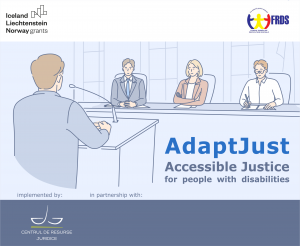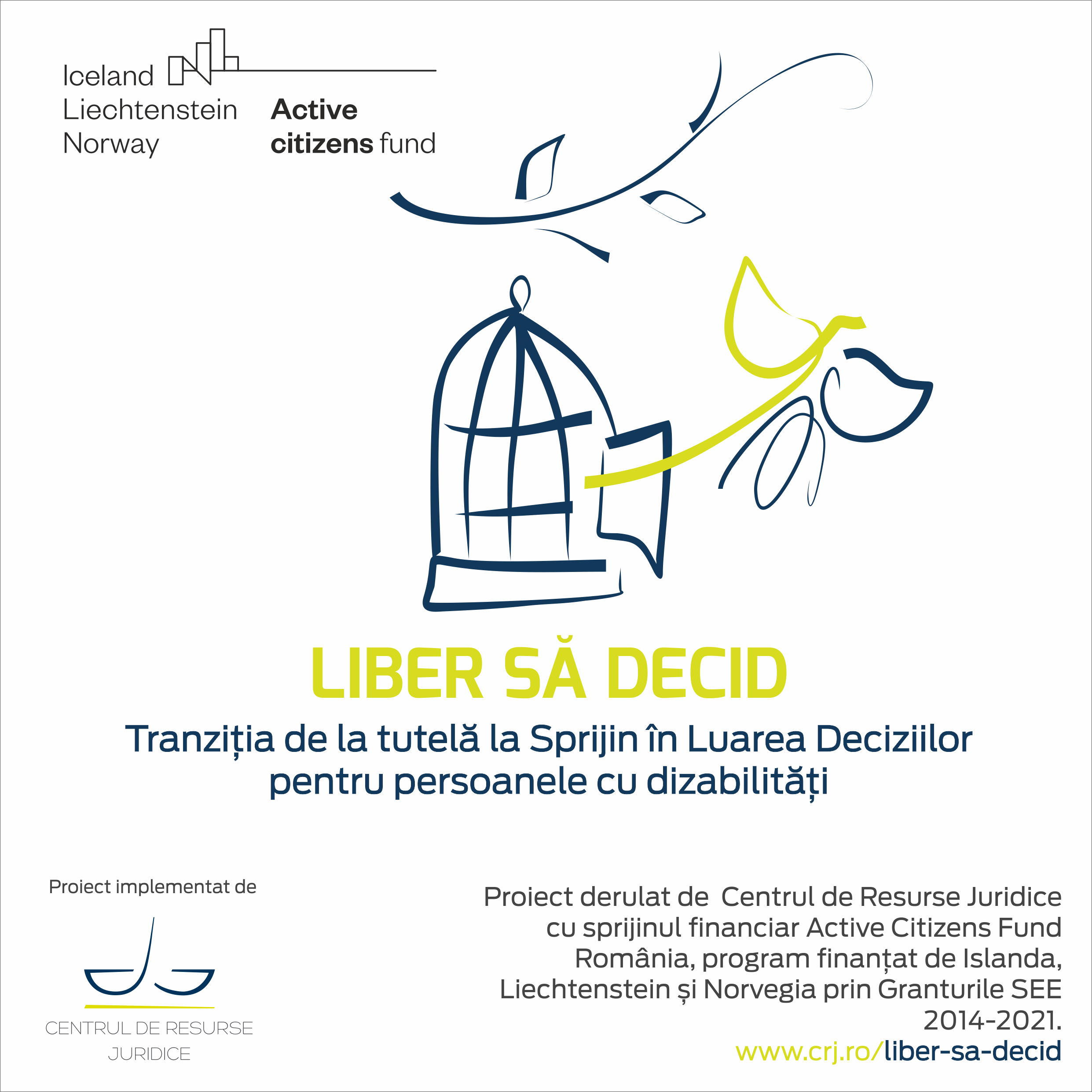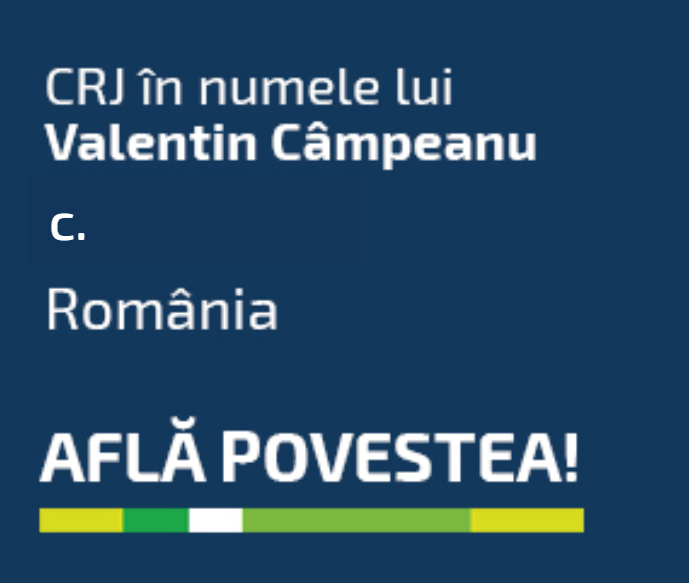Excerpts from the report:
- The representatives of the Centre for Legal Resources (CLR) organized between September and November 2022 several unannounced monitoring visits in three private social care homes (NGO and SRL) but also financed from public sources, for people with intellectual and psychosocial disabilities from Ilfov county.
- The social care homes visited were: Sfantul Gabriel cel Viteaz social care home for Adults with Disabilities, “Casa Cora” social care home for Dependent Persons and “Armonia” social care home for Adults with Disabilities .
- The “Armonia” social care home for Adults with Disabilities is located in a bordering area, at the exit from Afumaţi, Ilfov county, on Bucuresti-Urziceni Highway no. 36A. On the heavily trafficked street (entrance and exit artery from Bucharest), the social care home is surrounded by a high fence of approx. 2.5 m on which video surveillance cameras and warehouse buildings are mounted. In the immediate vicinity, the social care home adjoins a fuel station, OMV. […]
- If in September, upon arrival at the “Armonia” Social care home, only one employee was present and was busy cleaning the dining room on the ground floor of the building, in November 2022, there were two carers, women, the same male carer met in September and the nurse medical. Initially, from the information received, a number of 32 residents resulted. However, the information could not be officially confirmed in any of the visits carried out in 2022.
- The “Armonia” social care home was established by the St. Gabriel the Brave Association and holds provisional operating license 1358/12.07.2022 issued by ANPDPD (National Authority for the Protection of the Rights of Persons with Disabilities) on 12.07.2022 with a validity of 1 year, until 11.07.2023.
The method of admitting beneficiaries to social care homes where social services are provided (transfer of residents)
A considerable part of them stated that they do not know the reason why they live in this social care home, that they would like to leave, live somewhere else, that they were not asked if they wanted to live in this social care home, nor were they told they offered several options to choose from. Moreover, the discussions with the employees of the “Armonia” Social care home and with the head of the service for adults with disabilities, reinforced the hypothesis that the majority of residents are homeless people or who either come from closed placement social care homes, or have become “social cases” in psychiatric hospitals ( people who remained involuntarily hospitalized for years without a court sentence).
From the information received, the procedure by which the beneficiaries arrived at the respective social care homes was non-transparent and involved either: (i) the transfer of patients hospitalized in psychiatric hospitals to the respective care and assistance social care homes or (ii) the transfer of beneficiaries from other social care homes to the respective care and assistance social care homes visited, for various reasons – reorganization, abolition etc.
On the occasion of the second visit, from 01.11.2022, CLR representatives were able to observe the living conditions of the residents and were able to talk with some of them. There was a strong smell of feces and urine throughout the social care home. We met a resident who was sleeping on a metal bed on which there was only a mattress, no sheets, no pillow, covered only with a blanket. The clothes she was wearing were dirty and looked worn. Both the mattress and the blanket were dirty, including small, brown stains (possibly blood stains from bed bug bites, the entire social care home being infested with these parasites). From the discussion with the said resident, since she was brought to the social care home, containment methods were applied to her that were not ordered in accordance with legal procedures.
As detailed in the next chapter, living conditions in the “Armonia” Social care home are degrading, with residents living in unsanitary, vermin-infested quarters with only two bathrooms available on the social care home’s two floors, which were extremely dirty and did not appear to have functional plumbing (a shower tub with a hose coming out of the wall) and where all residents are supposed to wash, with no personal hygiene products available to each resident (such as toilet paper, towels, soap , shampoo, etc.).
Noting the living conditions of the residents of the “Armonia” Social care home, one of the representatives of the CLR contacted DGASPC Ilfov, requesting that the person responsible for the residents of the “Armonia” Social care home come to the site, to ascertain their situation. On this occasion, Mr. Răzvan Țicu presented himself around lunch, who had the position of Head of Service – adults with disabilities, is a case manager throughout Ilfov county and who, after visiting the social care home, informed us that he does not consider that those referred to us are serious violations that infringe on the rights of the residents, as long as they appreciate that the situation in this social care home is preferable to living on the street, especially since the beneficiaries have mental illnesses and have no other options. We do not know the institution’s official point of view on this matter. Also Mr. Țicu told us that although he is officially dealing with the situation of the people in question, he does not know what the procedure is for allocating people to the social care homes, he does not know if it is a public procurement procedure or what is the method on the basis of which it was concluded the service contract between DGASPC Ilfov and Social care home “Armonia”.
In the Care and social care home for Adults with Disabilities “Armonia” it seems that there were several deaths, but we were not given a clear number of them and a record of the causes that led to those deaths. The existence of these deaths resulted from the discussion with the medical assistant, Mrs. Claudia Costescu, who told us that she has been working in this social care home for approx. 1 year and only during this period there were approx. 8 deaths from her memories, the most recent being that of a 37-year-old young man (died on 24.10.2022). Requesting additional information about this case and about the procedure started following the death, we were informed that it was taken over by the family for burial and that the representatives of the social care home did not consider it necessary to notify the competent authorities, although the causes that led to it are not certain at the death of this young man. By asking the social worker for the social care home’s death register, we found that this death had not been registered at that time, although it had been approx. a week. On this occasion, we requested information about the other deaths and we were informed that they did not take place in the “Armonia” Social care home, but in the “Casa bunicilor” Nursing Home. Thus, from the information received, it would appear that two different social services operated or continue to operate in the same premises. With regard to the Old People’s Home “Casa bunicilor”, it is mentioned in the register “Homes for the elderly licensed on 26.07.2021 (social service code 8730 CR-VI)” [1], as having an operating license from 2021, valid for 5 years [2] , but we don’t know if this social service provider is still operating in this precinct or not.
However, what is essential is the considerable number of deaths that occurred in this social care home and the fact that from the information received, it does not appear that they were notified to the competent bodies, although the causes of their occurrence required reporting.
Life conditions:
The building in which the social care home operates consists of a ground floor and two floors; access to the floors is achieved from a narrow staircase from the outside of the building; the office of the specialized staff can only be accessed through the yard behind the house, if the gate leading into it is not locked. Apparently, the building “hidden” behind some 2.5m high fences and some cargo warehouses, looks like an unfinished construction, located somewhere on the edge of a dirt road at the exit from Afumati, Ilfov. An area heavily trafficked by cars and polluted. Nothing indicates that in the yard next to the gas station, at the exit from Afumaţi commune, more than 30 people are locked up.
The yard behind the social care home, a former orchard, was unkempt, dirty, with dirty mattresses and various debris thrown on the ground. We didn’t meet any residents in that yard. Most of them were seated on old pieces of furniture (leather sofas) in the cement-clad courtyard at the entrance to the building.
At the entrance to the premises, on the ground floor, on the left is the kitchen, on the right, a doctor’s office, in front is a large hall of approx. 150 square meters, in which the meal is served. In the same space, on the day of the visit in November, an elderly and apparently immobilized resident was lying on a leather couch . CLR asked the staff what are the reasons why she is not admitted to the hospital, the employees’ answer being ” the family does not want it and brought her here “. Also on the ground floor were other immobilized elderly people.
The entire ground floor area is monitored by video cameras. At the back of this hall are other bedrooms, two bathrooms and a storeroom with food (on the day of the visit there were two bags of onions and potatoes).
Initially, despite CLR’s insistence, the door to the room where the kitchen was located was not opened. The reason given was the lack of the key. We insisted on seeing the space also because CLR received information that food is being prepared there for the “Armonia” Social care home, but also for the St. Gabriel the Brave Social care home. Although the meal time had passed, the residents did not receive food because the CLR team was present in front of that premises. Immediately after CLR entered the social worker’s office, two pots with at least 40 liters of soup “appeared” on the floor in the hall. The employees reasoned that it was brought by the catering company with which they have a contract. According to the contract, food had to be delivered by 12:30. However, several people from the social care home confirmed that food is prepared in that kitchen, but that because of the mess and the untidy space, CLR’s access was restricted.
However, there was food stored in the refrigerator (sausages, eggs), packages of meat in the freezer, and bags of potatoes and onions in the pantry. When asking who all the food in the kitchen and pantry was for, the CLR representatives received equivocal answers – whether it belonged to the employees, who were cooking just for themselves in the social care home, or whether it belonged to one of them and was just storing it there.
The kitchen had unsanitary equipment, grease stains, mold, a heavy smell of spoiled food.
On the two floors, there were several bedrooms with 3-5 beds with metal structures, dirty and old mattresses, some rooms poorly lit, beds close together, no storage spaces, with non-functional toilets in the hallway, beds covered with dirty linens. The residents did not have their own storage space for personal items. Hallways and rooms were tiled.
On the walls of the rooms, the sheets on the beds, the mattresses and pillows – there were traces of blood and bedbugs. CLR indicated this infestation directly to the representative of DGASPC Ilfov and the employees of the “Armonia” Social care home. They acknowledged the fact that the situation is known but showed that DGASPC Ilfov is aware of the lack of financial funds for the payment of services.
Behind the building is a small undeveloped garden and the office for the administrative staff. This area is separated from the front yard by a metal gate, so residents do not have easy access to the offices of the administrative staff.
Both in the yard and inside the social care home there was a disgusting smell of urine that penetrated everywhere inside it also smelled of food, the kitchen being located immediately to the left of the main entrance, the rest of the ground floor being occupied by a large dining room and an area (in right side of the room) where there were couches and a TV.
Two toilets are open to access on the 1st floor and 2 disused bathrooms on the 2nd floor. Practically all residents could only use the 2 existing bathrooms on the 1st floor, one of which had a bathtub and the other a shower (which was actually a hose that was coming out of the wall), both bathrooms being in an advanced state of decay, showing dampness, mold, sanitary installations unfit for use and insufficient for the number of residents they should serve. On the ground floor, next to the dining room, there was also a service WC, but it did not work properly, so it could not be cleaned after each use, the employees brought a container of water from the hallway for sanitation. There was a closet in the 1st floor hallway with clothes that looked dirty and were hanging out of the closet.
Regarding the lack of hygiene products, the employees of the social care home told us that they are offered upon request. Beyond the fact that access to such things should be unimpeded, as long as basic needs are concerned, we have not identified a place where they exist and turn out to be sufficient for every resident anyway. Although most of the residents presented an unkempt posture, clothing and appearance, in the files presented by the social worker who later came to the social care home, it was shown that almost weekly the residents benefited from sanitizing procedures such as haircuts, nail trimming, even painting (although the face of the place, only one of the residents was dyed – although with a man’s haircut – being in fact the resident who complained about non-conformities, abuses and forced internalization in that social care home).
All the rooms were infested with bedbugs, and by the degree of infestation, one could conclude that the problem was old and unsolved until that time. The existence of this contamination was also confirmed to us by Mrs. medical assistant, but also by the head of the social care home who justified himself by using the lack of funds, namely that DGASPC Ilfov, with which the social care home has a contract for the provision of social services, has not paid the invoices of approx. 6 months.
All the residents looked unkempt, they were sad and those who could communicate told the CLR team that they wanted to leave the “Armonia” Social care home as soon as possible.
CLR informed the management of DGASPC Ilfov about the fact that already in September 2022, it notified in writing that one of the residents wants to be allowed to leave the “Armonia” Social care home. The young woman filed a complaint both with DGASPC Ilfov and with the police. DGASPC representative Ilfov replied that she cannot be allowed to leave and that they did not answer her because “she will stay there anyway”.
Social care home staff:
- In the “Armonia” Social care home we identified only 3 caregivers or nurses and 1 medical assistant, these people being responsible for the 32 residents;
- Moreover, as we showed previously, taking into account the fact that elderly people and people with disabilities were institutionalized in this social care home, we appreciate that this social care home should have complied with all the requirements of Annex no. 1 of Order no. 82/2019 and be properly licensed to be able to properly care for and assist beneficiaries with disabilities.
- Although as previously mentioned, at the time of the first visit to the social care home for Adults with Disabilities “Armonia” we were not able to obtain enough information, we state that at the time of the visit, there was only one person in the social care home, responsible for all those approx. 32 beneficiaries who also cleaned the dining room (we did not identify the position he held).
- On the second visit, from 01.11.2022, upon the arrival of the CLR representatives, only the nurse, a nurse and the same gentleman from the first visit were present (we still do not know his position or his duties) . After the arrival of the police team, the second nurse also arrived at the social care home, the social worker, the psychologist and a man who seemed to have administrative duties, but who also brought lunch for the residents and who also had keys to locked spaces (we don’t know the function he had or the duties that belonged to him – but from the information gathered on the spot, he seems to be related to the administrator of the social care home, being his brother). After lunch, the administrator of the association, Mr. Ștefan Godei who explained to us that the situation found by us is due to the fact that for more than 6 months, DGASPC Ilfov has not paid the invoices representing the allowances due for each beneficiary for which this institution is responsible.
Activities:
Regarding the daily regime , the existence of a range of occupational and recreational activities offered to residents was not observed. The employees presented several minutes from which it emerged that the residents would have carried out activities such as going to the market to purchase seasonal fruits and vegetables, although in fact the residents complained that they were forbidden to leave the social care home at all .
The CLR observed that residents were not encouraged to participate in activities, there was nothing structured, and any activities did not follow any resocialization plan. Indeed, the main part of the activity seemed to be sitting in the yard or in bed.
And in this social care home coordinated by the same provider, the main object seemed to be isolation, maintaining order and trying to satisfy at a minimal level only the basic needs of the residents. The situation had been aggravated by the fact that, although there were no restrictions on daily outdoor exercise inside the premises, the possibilities of going out to the market, shop, on the street, in parks or on recreational trips outside the social care homes did not exist. In the two social care homes, most residents spent a large part of their days under a rigid regime that made them sit on old furniture in the courtyard (Smoky), crowded, noisy, watching a television mounted high on the wall, close to ceiling; rather than engaging in any meaningful activity.
The existing arrangements for contact with the outside world were generally unsatisfactory in this centre. Residents cannot keep in touch with people from outside, most of them being unable to access mobile phones or the Internet.
Complaints mechanisms and the provision of information on residents’ rights were also missing in this social care home. The residents told us that they do not have access to the internet, phone, paper and writing instruments to make reports/complaints, we have not identified registers in which the reports made by the residents were documented. They also told us that they are not given a phone to use as needed.
Means of containment – restraint and isolation
One of the residents of the “Armonia” Social care home told the CLR team that her arms and legs were tied when she arrived at the social care home. The person was clearly affected by the containment and isolation measures applied. The person’s appearance was unkempt, her hair was cut with a machine (a haircut that all the residents had – they were cut by employees with a clipper – regardless of whether they were women or men and without obtaining consent) and she was scared of what happened to her. would happen if the staff finds out that she is dissatisfied with the “treatment” she receives at this social care home.
Most of the residents also complained about the inhumane conditions in which they were accommodated in the psychiatric hospital and in the dormitory in Bălăceanca. The representatives of DGASPC Ilfov showed that they are aware of these, but that they have not taken steps to notify the competent institutions.
Many of the people CLR met during this visit stated that they prefer to live on the street than locked up in the “Armonia” Social care home. CLR notified DGASPC Ilfov about the right of people to choose where, how and with whom they live and that the legislation in force obliges the public authorities to support them in the necessary steps and not to lock them up in unhealthy and unworthy conditions.
Requests addressed to institutions that have competence in the matter:
- We request the President of ANPDPD and the director of ANPIS to check the legality of the transfer procedures and the presence of people with intellectual/psychosocial disabilities in the “Armonia” Social care home for Adults with Disabilities ;
- We request the Minister of Health to verify whether the procedure for maintaining involuntary hospitalization for persons hospitalized at Bălăceanca Hospital is respected;
- We request the DGASPC Director Ilfov to check the way in which the residents of the Social care home for Adults with Disabilities “Armonia” are institutionalized – considering the suspicions of arbitrary institutionalization and taking into account Romania’s conviction in the case of N. against Romania ;
- We request the Public Ministry to investigate the fact that in the social care homes in Romania there are cases of “suspicious death” that are not properly registered and investigated – taking into account Romania’s conviction in the CLR case on behalf of Mr. V. Câmpeanu v. Romania ;
- We request the Ministry of Labor and ANPDPD to make public and transparent the procedures for the transfer of beneficiaries from one social care home to another, the number of beneficiaries in each social care home (including social care homes that operate on the basis of a provisional license), the place of origin of the beneficiaries and who is responsible for the services made available to them. We also request the Ministry of Labor and the Monitoring Council to make available to the Public Ministry data on deaths registered in private social care homes financed by public and/or private funds (number, causes) as well as data on the number of people with disabilities institutionalized in social care homes for people elderly.
Material developed within the AdaptJust project – Accessible justice for people with disabilities, implemented by the Centre for Legal Resources in partnership with the Public Ministry – the Prosecutor’s Office attached to the High Court of Cassation and Justice, a project that benefits from a grant in the amount of €1,324,994 , offered by Iceland, Liechtenstein and Norway through the EEA Grants 2014-2021, within the Local Development Programme. The material is made available free of charge and may be distributed only by mentioning the source. Modification in any way, sale or commercial use of the content is strictly prohibited. Its content does not reflect the official opinion of the Program Operator, the National Contact Point or the Office of the Financial Mechanism. The information and opinions expressed are the sole responsibility of the author(s). We work together for an inclusive Europe.
[1] Available at URL: http://mmuncii.ro/j33/images/Documente/Familie/26072021_Camine_persoone_varstnice.pdf
[2] License no. LF/0009143 from 01.02.2021;





